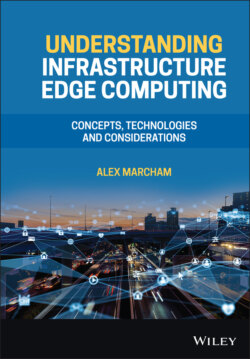Читать книгу Understanding Infrastructure Edge Computing - Alex Marcham - Страница 28
2.5.1 Latency
ОглавлениеThe time required for a single bit, packet, or frame of data to be successfully transmitted between its source and destination can be measured in extreme detail by a variety of mechanisms. Between the ports on a single Ethernet switch, nanosecond scale latencies can be achieved, though they are more frequently measured in microseconds. Between devices, microsecond or millisecond scale latencies are observed, and across a large‐scale WAN, such as an access or last mile access network, hundreds of milliseconds of latency are commonly experienced, especially when the traffic destination is in a remote location relative to the source of the data, as is the case when a user located on the device edge seeks to use an application being hosted in a remote centralised data centre facility.
Latency is typically considered to be the primary performance benefit which edge computing and particularly infrastructure edge computing can provide to its end users, although other performance advantages exist such as the ability to avoid current hotspots of network congestion by reducing the length of the network path between a user and the data centre running their application of choice.
Beyond a certain point of acceptability, where the required data rate is provided by the network to the application for it to function as intended, increasing the bandwidth and therefore the maximum data rate that is provided to a user or application on the network for a real‐time use case does not measurably increase their quality of experience (QoE). The primary drivers of increased user QoE are then latency, measured at its maximum, minimum, and average over a period of time, and the ability of the system to provide as close to deterministic performance as possible by avoiding congestion.
The physical distance between a user and the data centre providing their application or service is not the only factor which influences latency from the network perspective. The network topology that exists between the end user and the data centre is also of significant concern; to achieve the lowest latency, as direct a connection as possible is preferable rather than relying on many circuitous routes which introduces additional delay in data transport. In extreme cases, data may be sent away from its intended destination before taking a hairpin turn back on a return path to get there. This is referred to as a traffic trombone, with the path which the data takes resembling the shape of the instrument.
